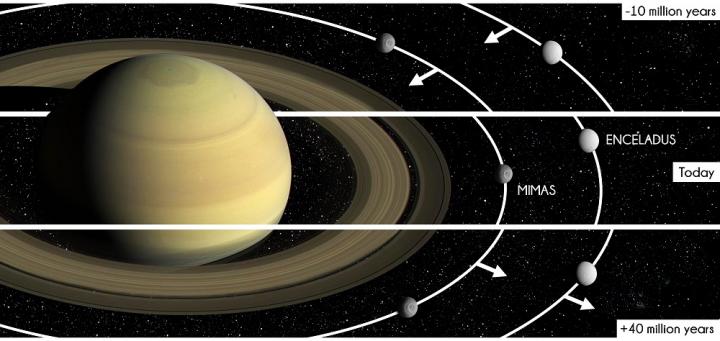Saturn's moon Mimas, a snowplough in the planet's rings

10 million years ago, Saturn's moons moved inwards, opening up the Cassini Division. In 40 million years time, the moons will have moved out far enough for it to close up again. Credit: Cassini, Dante, Baillié and Noyelles
Saturn's rings are made up of ice particles whose orbital velocity increases the closer they are to the planet. The Cassini Division is a wide, dark band located between Saturn's two most visible rings, in which the particle density is considerably lower than that inside the rings.
The researchers suspected a link between Mimas, one of Saturn's moons, and the band, since there is a region at the inner edge of the Division where the particles orbit around Saturn exactly twice as fast as Mimas.
This phenomenon, known as orbital resonance, pushes the ice particles apart, producing a relatively narrow gap. Scientists from CNRS, the Paris Observatory – PSL and the University of Franche-Comté have now shown that Mimas may have moved closer to Saturn in the recent past, making the moon a kind of remote snowplough that widened the initial gap, giving it the 4500 km width it has today.
If on the other hand the orbit of Mimas moved outwards, the particles would return to their original position, rather as if a snowplough were to reverse and stop pushing the snow, letting it spread out again. Using numerical simulations, the researchers calculated that Mimas must have migrated inwards by 9000 km over a few million years in order to open up the 4500 km gap that currently makes up the Cassini Division.
A natural satellite, such as the Moon, normally tends to move away from its planet rather than closer to it. In order to migrate inwards, a moon has to be able to lose energy, particularly by heating up, which would cause its internal ice to melt and weaken its outer crust.
However, the state of Mimas' surface, which still bears the scars of relatively ancient meteorite impacts, does not tally with such a scenario. The researchers' second hypothesis, which remains to be confirmed, is that the loss of heat was shared out between Mimas and Enceladus, another of Saturn's moons, through orbital resonance.
This would have caused the creation of the internal oceans that the Cassini spacecraft detected below the surface of both these bodies.
Today, Mimas has begun to migrate outwards again. According to the researchers' calculations, the Cassini Division is likely to take around 40 million years to close up again. Thanks to these findings, scientists may view the presence of gaps in the rings of an exoplanet as a clue that it could have moons with oceans.
###
*The researchers belong to the Institut de Mécanique Céleste et de Calcul des Éphémérides (Observatoire de Paris – PSL / CNRS), Institut UTINAM (CNRS / Université de Franche-Comté), Institut de Physique du Globe de Paris (CNRS / Université de Paris / IPGP / IGN), Laboratoire de Planétologie et Géodynamique (Université de Nantes / CNRS / Université d'Angers), Namur Institute for Complex Systems (Université de Namur), and the Jet Propulsion Laboratory (NASA).
Bibliography
Formation of the Cassini Division – I. Shaping the rings by Mimas inward migration
Kevin Baillié, Benoît Noyelles, Valéry Lainey, Sébastien Charnoz, Gabriel Tobie, Monthly Notices of the Royal Astronomical Society en Juin 2019
Formation of the Cassini Division – II. Possible histories of Mimas and Enceladus
Benoît Noyelles, Kevin Baillié, Sébastien Charnoz, Valéry Lainey, Gabriel Tobie, Monthly Notices of the Royal Astronomical Society en Juin 2019
Media Contact
More Information:
https://www.cnrs.fr/en/saturns-moon-mimas-snowplough-planets-ringsAll latest news from the category: Physics and Astronomy
This area deals with the fundamental laws and building blocks of nature and how they interact, the properties and the behavior of matter, and research into space and time and their structures.
innovations-report provides in-depth reports and articles on subjects such as astrophysics, laser technologies, nuclear, quantum, particle and solid-state physics, nanotechnologies, planetary research and findings (Mars, Venus) and developments related to the Hubble Telescope.
Newest articles

Superradiant atoms could push the boundaries of how precisely time can be measured
Superradiant atoms can help us measure time more precisely than ever. In a new study, researchers from the University of Copenhagen present a new method for measuring the time interval,…

Ion thermoelectric conversion devices for near room temperature
The electrode sheet of the thermoelectric device consists of ionic hydrogel, which is sandwiched between the electrodes to form, and the Prussian blue on the electrode undergoes a redox reaction…

Zap Energy achieves 37-million-degree temperatures in a compact device
New publication reports record electron temperatures for a small-scale, sheared-flow-stabilized Z-pinch fusion device. In the nine decades since humans first produced fusion reactions, only a few fusion technologies have demonstrated…





















